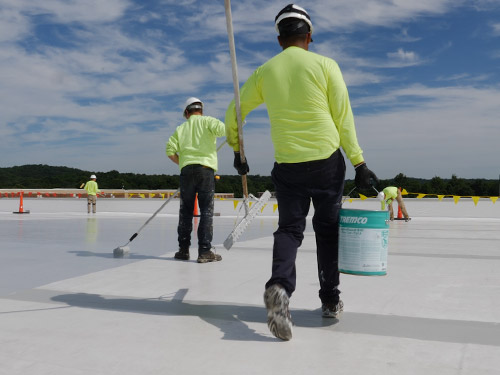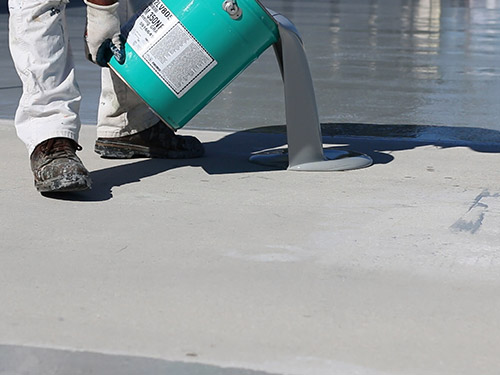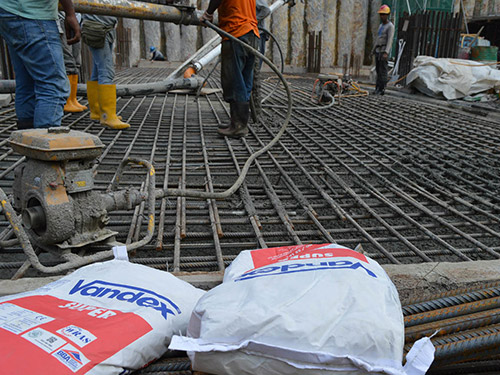In order to construct a building that will stand the test of time, one of the key factors is the application of high-quality waterproofing. A building with no waterproofing or poorly designed and installed waterproofing will most likely face the following problems down the road.
Building deterioration
 Steel reinforcement used in concrete construction is subject to corrosion. Concrete is a porous material that will allow water penetration which will eventually reach the steel reinforcing bars embedded in the concrete. This water can cause corrosion or rust.
Steel reinforcement used in concrete construction is subject to corrosion. Concrete is a porous material that will allow water penetration which will eventually reach the steel reinforcing bars embedded in the concrete. This water can cause corrosion or rust.
When the steel reinforcement rusts, it exerts an outward pressure on the concrete which can lead to spalling and cracking. Spalling and cracking of the concrete will eventually weaken the structural integrity of the concrete structure.
The proper installation of an integrated, quality waterproofing system on a concrete structure can extend the life of the structure by as much as 25 to 50 years compared to the structure without waterproofing or with a poorly designed and installed waterproofing system.
Expensive repairs
While you may think that the initial cost of smart waterproofing may be too expensive, the typical cost of a quality waterproofing solution on most buildings is between 1-3% of the total construction cost.
Repairing structural damage or interior damage caused by water leakage can cost many times more than the initial installed cost of the waterproofing system. Furthermore, that does not include the potential cost and disruption to the building’s occupants during any repair or mitigation works.
Water damage repairs are very expensive, so it is important to remember that prevention is far better than cure when it comes to waterproofing.
Mould and mildew
Mould and mildew are common side effects of water damage. Mould and mildew can cause a deterioration in indoor air quality and can pose the risk of serious respiratory illness to the individuals residing within the building.
Solution to Poor Waterproofing
Schedule regular checks
Leaks in drains, plumbing and irrigation are hard to spot, making regular inspections an absolute necessity in building maintenance. Drainage systems and plumbing should be checked for any blockages or drips and any leak, however small must be fixed immediately. An expert should be consulted to resolve the problem.
Ensure all seals are maintained
Windows, doors and walls are highly vulnerable to leaks, requiring building managers to constantly check all window seals, door seals and even wall systems.
Concrete is a porous substance and can allow water through. Occasionally, leaks may not be visible, but moisture could still be getting through the wall. If water damage is detected, please engage the professionals to rectify the situation.
Engage certified waterproofing applicators
Certified applicators have the protective clothing and tools required to safely install waterproofing systems and are trained to recognize potentially dangerous problems that may not be evident to the average person.
Product Warranty
Ensure the products and systems used for waterproofing come with a long warranty period of 10 years or more. This will give a peace of mind knowing that you are receiving expert service and that everything is done with strict adherence to safety guidelines.
Waterproofing Specialist
Tremco specialises in waterproofing solutions for over 90 years. Our expert team are on hand to help you in any current or upcoming project you may have, do get in touch with them.


 Waterproofing and Roofing
Popular Types of Commercial Roofs and Waterproofing Systems
Waterproofing and Roofing
Popular Types of Commercial Roofs and Waterproofing Systems
 Waterproofing and Roofing
Sheet vs Fluid Applied Waterproofing
Waterproofing and Roofing
Sheet vs Fluid Applied Waterproofing
 Concrete, Waterproofing and Roofing, Infrastructure
The 5 Main Benefits of Crystalline Waterproofing
Concrete, Waterproofing and Roofing, Infrastructure
The 5 Main Benefits of Crystalline Waterproofing
